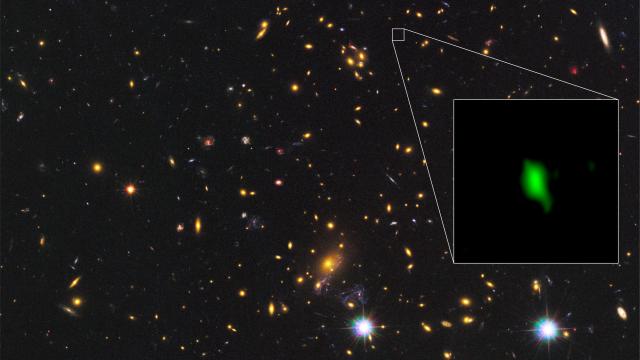Scientists have spotted 13-billion-year-old oxygen in a distant galaxy – a signal of stars forming during the universe’s earliest days.
Locating the oldest galaxies and understanding how they contributed to the evolution of our universe is perhaps one off astronomy’s key goals, say the scientists behind the new results in their just-published paper. The international team looked at a distant galaxy and found it contained the universe’s oldest oxygen yet – implying it had probably experienced an earlier star-forming period during a time from which there are few astronomical observations.
“We can show with this observation that the first galaxies were already present 250 million years after the Big Bang,” study author Nicolas Laporte, from University College London, told Gizmodo.
The scientists were already aware of MACS1149-JD1, a galaxy from around 500 million years after the Big Bang, based on previous measurements from the Hubble Space Telescope. We’re able to observe this galaxy because its appearance is magnified in the sky, thanks to a warp in spacetime caused by a massive object located between us and it.
For this work, the researchers used the Atacama Large Millimetre/submillimeter Array in Chile to spot what appeared to be the signature infrared light from electrons colliding with oxygen, but stretched out from the expansion of the universe. They also detected tentative evidence of the light from hydrogen in this galaxy, coming from the same place in the sky and distance, providing further evidence for the origin of their oxygen signal.
The researchers’ modelling revealed that in order for a more complex atom like oxygen to appear in this ancient galaxy, it must have been going through a second wave of star formation – and the first wave would have occurred 300 million years earlier.
Basically, the gas and the supernova deaths of the first wave of stars could have caused further star formation and the oxygen signal the scientists observed. The researchers published their results today in the journal Nature.
This oxygen signal is another hint at the universe’s earliest period of star formation. It joins the data from just a few months ago, when an Australian radio antennae detected a long-sought signal of the first stars’ hydrogen interacting with light from the Big Bang.
“I think this paper is very important,” Aparna Venkatesan, professor in physics and astronomy at the University of San Francisco, told Gizmodo. Venkatesan, who was not involved with the new study, pointed out that it’s nice to see multiple lines of evidence pointing to the fact that stars were forming during this time.
The study has its limitations, though. “I think the one thing that’s a little uncertain is the star formation history,” she told Gizmodo. In other words, the researchers’ story is basically just a way to interpret the data, and might not be exactly what happened. But she pointed to other experiments, such as the SOFIA infrared observatory, that will observe more nearby galaxies that may look similar to some of the universe’s ancient galaxies. These could help refine the story.
And this galaxy could foreshadow exciting discoveries from upcoming telescopes. The James Webb Space Telescope, for example, might be able to resolve galaxies during this early stage of formation, beyond the view of the Hubble Space Telescope. ALMA would also play a role in performing followup investigations on these first-generation galaxies, too.
There’s a whole lot more to learn about this strange universe we live in. And even in tiny, distant blips of light, there could hide billions of years of cosmic history.
[Nature]
